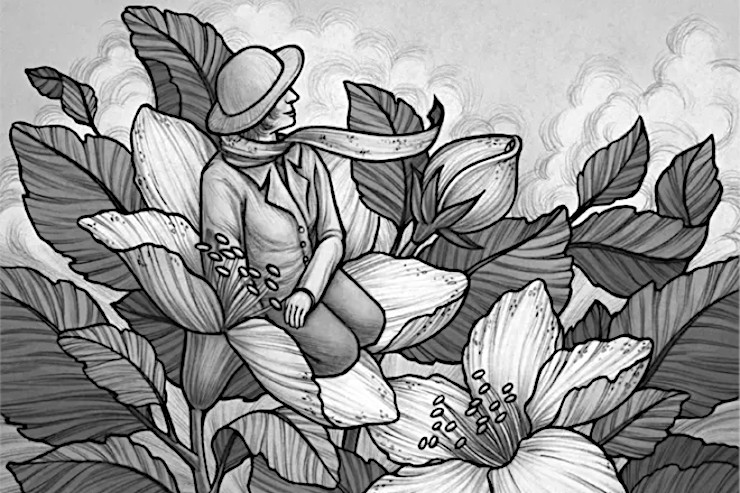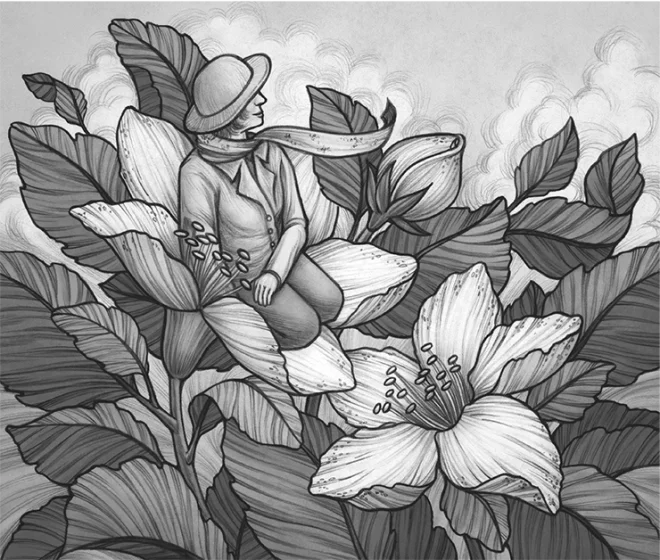
We’ve talked before about having gardening friends, and what fun it is to have people who will exchange seeds and cuttings with you, but I never thought too deeply about the significance of it, or growing a garden of remembrance, until I read today’s piece by Marianne Willburn. It’s about staying connected to bygone loved ones, and it’s called, The Garden Remembers.
In her story, she visits the garden of her godmother “Auntie Derith” who recently passed away. She wants to bring home her St. John’s Wort. She writes, “In a modest little garden in Oregon’s Bandon-by-the-Sea, this plant had strong-armed its way through beds and pots, stopping short only in the face of concrete steps and walkways.” I’ve never grown St. Johns Wort, but it sure sounds like a fighter!
In the story, she recalls memories of her godmother, including how much she loved her birthday, even resorting to quarter-year birthdays as she got older! But what I love most about this story is the reflection it offers as a garden of remembrance with plants from dear friends and relatives: “Aunt Derith’s hypericum; my friend Mary Ann’s golden privet; a precious aloe from Phil’s garden in California; the choice to line walkways with grasses á la Jeanne.”
It makes me want to grow a more significant garden than just “Hardwick Co-op’s sale bin daisies” and “Those Bloomerangs I’ve been trying to find for two years.” I need to find myself more gardening friends, indeed! Keep reading for her full story; it’s inspiring, as you can tell!
Get More Stories About Healing Gardens
This story comes from our archive that spans over 30 years and includes more than 130 magazine issues of GreenPrints. Pieces like these that turn the stories gardening into everyday life lessons always brighten up my day, and I hope this story does for you as well. Enjoy!

The Garden Remembers
Staying connected to bygone loved ones.
By Marianne Willburn
This morning I caught my breath when I found new shoots breaking through the soil on a St. John’s Wort I’d brought home from Oregon several weeks ago. I thought it had died. Hypericum calycinum is not a difficult plant, nor as rare as the exotic nursery finds that had shared its cramped suitcase on my flight home. But as with many plants in our lives as gardeners, its origin gives it a special place in my affections.
In a modest little garden in Oregon’s Bandon-by-the-Sea, this plant had strongarmed its way through beds and pots, stopping short only in the face of concrete steps and walkways. The garden was that of my much-loved godmother—my Auntie Derith—who had passed away days before my visit. With my daughter, Emma, and Ollie, a friend and caregiver of my aunt, I wrestled with the St. John’s Wort for a couple hours, only to impulsively throw a few hacked cuttings in a bag as we left the house for the last time.
We had been tidying the garden, the way one does when one doesn’t quite know what else to do in the face of grief. My aunt may or may not have approved, as she took great joy in the wildness of her yard. My Aunt Derith proudly went by the title of “Miss” for all of the 89 years she spent on this Earth—the quintessential English spinster with a lively sense of humor and a sharp tongue when vexed. She was frugal to the point of absurdity and kept a container under the faucet to catch every spare drop of water for later use. Staying with her as an over-bathed American teenager was a test of both our temperaments, and lectures were severe and terrifying.
But she was the only woman I have ever known who loved her birthdays—to such an extent that in her later years she began to celebrate her half-birthdays, “In case I don’t make it to my next one, my dear!” At 87, she began celebrating her three-quarters-birthdays, and succeeded in shaming me for dreading my own, as I was more than forty years her junior.

During World War II, she had driven trucks in Italy, later emigrating to America on an ocean liner, wearing a headscarf against the wind, which, thanks to the kindness of Ollie, now belongs to me. And after many years in San Francisco (on whose famous hills she taught me to drive a stick shift), she moved to Bandon and began a new life in her early sixties—a testament to our power as human beings to take charge of our lives and live with purpose, no matter what age.
It is a function of life that we will experience greater loss as we grow older. I have certainly proven the rule this year, with too many loved ones lost—in turns grieving and being grateful that I have not been faced with such loss earlier in my life. And it may be trite, and too oft cited by garden writers, but my garden connects me to those people every day: Aunt Derith’s hypericum; my friend Mary Ann’s golden privet; a precious aloe from Phil’s garden in California; the choice to line walkways with grasses á la Jeanne. How thankful I am to have these reminders of people who have shared their lives with me and made my life richer.
St. John’s Wort is used for the cure of melancholy and depression, and certainly on this quiet, overcast morning, the sight of these new shoots has made me smile and allowed me to write these words. No doubt I will be tearing out fistfuls of this aggressive spreader in a few years, smirking in the irony of it all and worrying that it will take over my garden. But then, worry is pointless, as Auntie Derith often reminded me by reciting this, her favorite saying:
“In this life, there are only two things to worry about: Either you are healthy or you are sick. If you are healthy, then there is nothing to worry about. But if you are sick, then there are only two things to worry about: Either you will get well or you will die. If you get well, then there is nothing to worry about. But if you die there are only two things to worry about: Either you will go to heaven or to hell. If you go to heaven, then there is nothing to worry about. And if you to go hell, you’ll be so darn busy shaking hands with your friends you won’t have time to worry.”
It’s not the same without her snorts and giggles at the end, but the sentiment stays with me and will remind me to approach my birthday a little differently this year. And wherever we end up shaking hands and kissing cheeks in the hereafter, I look forward to it. ❖
By Marianne Willburn, published originally in 2016, in GreenPrints Issue #106. Illustrated by Kate O’Hara

Do you have a garden of remembrance, full of memories and friendships? What’s your favorite cutting from a friend or relative?



